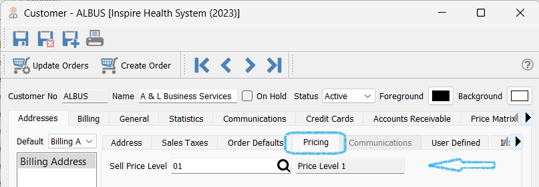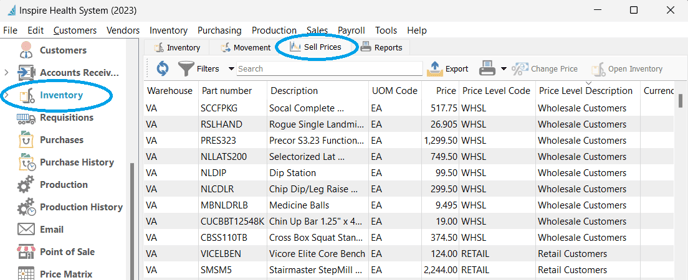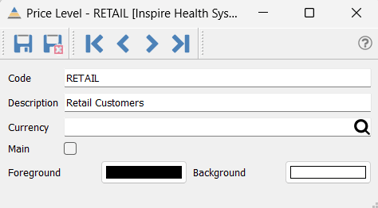Understanding Inventory Units of Measure / Levies / Pricing

Units of Measure
– option to establish more than one unit of measure, to be used in conjunction with purchasing, selling or tracking stock- New Unit of Measure
- click
 New and the fields will open up to enter the following information:
New and the fields will open up to enter the following information:
- click
-
- Set Sales UOM - establishes this UOM as the default for all new Sales Orders (can be changed inside the order)
- Set Purchase UOM - establishes this UOM as the default for all new Purchase Orders (can be changed inside the order)
- enter the new Code of up to 10 characters, and Description
- enter the Quantity Factor (conversion of this unit from the Stock Unit)
- option to allow
 Fractional Quantities on a Sales Order or Purchase Order
Fractional Quantities on a Sales Order or Purchase Order - enter checkmark under
 Sell if this UOM is allowed to be selected in Sales Orders
Sell if this UOM is allowed to be selected in Sales Orders - enter checkmark under
 Buy if this UOM is allowed to be selected in Purchase Orders
Buy if this UOM is allowed to be selected in Purchase Orders - option to establish the warehouse Location for this unit of measure
- option to establish the Weight for this unit of measure (used on pick/ship lists)
- accept or change the Sell Price(s) for the new unit of measure in one of two ways in the Pricing section:

-
- select the Unit of Measure and manually enter the price (ie $150.00)
- enter a Price Factor (12 is shown here) which will calculate from the Stock Unit of Measure Sell Price
-
- Set Default Unit of Measure in Edit > Company Settings > Inventory >Miscellaneous >

Levies
- if this Inventory Item attracts charges that need to be reported (ie: disposal fees) 
- Levy setup:


- set a unique Code of up to 3 characters
- enter a Description
- assign the Amount by
 $ or
$ or  %
% - option to assign a Sales Tax Provider Code (see Avatax Integration)
- enter any Sales Tax Code that this Levy is exempt from (see Inventory - Sales Tax Exceptions)
Pricing
set an unlimited number of Sell Prices per Inventory item and link them to your Customers
 establish a new Sell Price
establish a new Sell Price
- select from pre-set Price Levels (see Price Level setup below)

- option to establish an Effective Date for this price
- set the Sell Price in one of 3 ways:
- enter the price in manually
- use the
 Set Margin - select a Cost basis then value for this Price calculation
Set Margin - select a Cost basis then value for this Price calculation - use the
 Set Markup - select a Cost basis then value for this Price calculation
Set Markup - select a Cost basis then value for this Price calculation
- once options described above are set, there is a further option to
 Adjust By %
Adjust By % - set
 Round Price to select the number of decimal places you want in this Price
Round Price to select the number of decimal places you want in this Price
- select from pre-set Price Levels (see Price Level setup below)
-
- link to your Customers - Customers > Addresses tab > Pricing sub-tab > Sell Price Level

-
-
- if the Customer is assigned a foreign Currency, no need to assign a Sell Price Level, as Spire will automatically assign the correct Currency-assigned Sell Price Level (see Price Level setup below)
- Edit existing Sell Prices by selecting the Price and click on
 Change Price
Change Price
- also manage all Sell prices through the Inventory module :
-

-
-
-
- select the Sell Price(s) you wish to change and click
 Change Price (or double-click on the Sell Price line
Change Price (or double-click on the Sell Price line
- select the Sell Price(s) you wish to change and click
-
-

-
-
-
-
- select Create New (using the selected Price(s) as a template) or Change Existing
- select Create New (using the selected Price(s) as a template) or Change Existing
-
-
-

-
-
-
-
-
- create / change your Sell Price in one of 3 ways:
- manually enter the Sell Price in the grid
- use the
 Set Margin - select a Cost basis then value for this Price calculation
Set Margin - select a Cost basis then value for this Price calculation - use the
 Set Markup - select a Cost basis then value for this Price calculation
Set Markup - select a Cost basis then value for this Price calculation
- once options described above are set, there is a further option to
 Adjust By %
Adjust By % - set
 Round Price to select the number of decimal places you want in this Price
Round Price to select the number of decimal places you want in this Price - option to
 Remove Conflicts to ensure you are not creating duplicate prices
Remove Conflicts to ensure you are not creating duplicate prices
- create / change your Sell Price in one of 3 ways:
-
-
-
-
 Price Levels
Price Levels

 setup a new Price Level
setup a new Price Level

- establish a unique Code

- assign a Description of choice
- assign the foreign Currency of the Customers this price will be used for (no need to assign this if it's a base currency price)
- establish if this is the Main price, whereby this price will load in a Sales Order if no other Price Level is chosen in the Sales Order, and if there are no other price or discount settings loading from the Price Matrix (you can establish one Main Price Level per currency)
- assign a unique Foreground and Background colour for display in these areas:
-
- Price Levels List > Description column
-
- Inventory > Selling Prices tab - Price Level Description column
- Sales Order - Unit Price field
-
- Prices and Units List Customization - see Inventory List Customization
for other pricing options, see also Price Matrix
.png?height=120&name=Gemini-Logic-Logo%20(1).png)